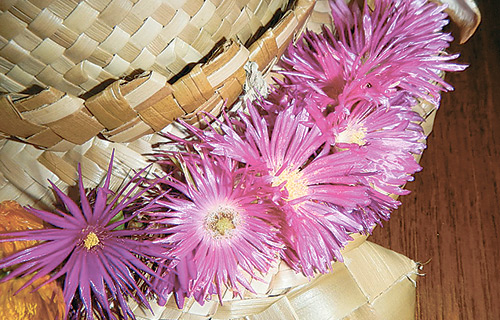Akulikuli is a favorite old-time lei, a Hawaiian kamaaina adaptation. It grows well only in certain higher elevations of the islands, such as Lanai City, Waimea on Hawaii island and Upcountry Maui.
I was visiting Maui and gave a slide lecture to the Native Hawaiian Plant Society, one of the foremost promoters and perpetuators of native plants. Many lovely people offered me a stay at their homes and to see their gardens. I ended up in Kula with an old University of Hawaii horticulture buddy, Lisa Schattenberg Raymond; her husband, Kiope; and son, Kua Ola. She has a garden full of ono edibles, medicinal plants and wauke (paper mulberry, used for making kapa). Lisa is a premiere wauke artisan, dye-maker and kumu at University of Hawaii Maui College.
We were enjoying her garden, harvesting some fresh greens, beets and veggies for dinner, wandering around looking at rare natives that thrive up mauka with good horticulture, in the evening light and checking how she grows things, her wauke projects, ipu (gourd) art and so on.
She said, "Eh, Heidi, want to make an akulikuli lei tomorrow?" Yes! I have never made one before. I tried to grow it, but it didn’t thrive in Makiki (too low) or in Wahiawa (high enough but too wet).
I was on Lanai in 1985 and was given one — the pale pink form of akulikuli — by Nalani Blaisdell’s auntie, who lived there. It was my birthday, and Auntie gave one to me and one to our kumu and hike leader, famed naturalist Lorin Gill. It’s still a memory I cherish.
So Lisa and I got up early and waited for the sun to warm the mountain slopes and just barely open the akulikuli blossoms. We got some old tin basins and picked the flowers. You want to pick them at just the right fat bud stage and then string them. We sat down on a mat and laid out the glorious colors.
This is how to make lei! Take your time, do it with friends, talk story and create perishable, wearable precious art.
Interestingly, Kiope was reading the Star-Advertiser and talking story with us as we strung our lei into special colorful patterns. Some people do it in ranks of five buds, some make bands of colors, some make it all kalakoa (mixed colors). There is a white blossom that was favored by the paniolo of Waimea for their lei papale (hat lei). Ooh, that’s great for moonlit, romantic horseback rides, no? That glimmer of silver white in the moonlight or dark night.
We made several lei and still had time to visit some special native gardens, pack up the lei in large Ziploc bags with air puffs and into the cooler or refrigerator, and then get to the airport so I could stand in a security line for an hour.
Even that was OK, sort of, because the miniature lei I had wrapped into my hair bun was a fun conversation starter. Kamaaina were thrilled to see it, and a nice tourist lady from Wisconsin who was behind me in the interminable line said it was so pretty and asked if it was real. Nothing like that grows in Wisconsin!
I wanted to give the lei to my mom for church, and she also had a keiki luau to attend, so the akulikuli lei was perfect for both occasions. I kept it chilled, took it to her early on Sunday and, as Lisa had taught me, shared that the buds would open with her body heat. If you are gentle and care for them by dry-wrapping them in Tupperware in the fridge, they will last for several days or a few special occasions.
Akulikuli is from South Africa. Plant scientists call it Mesembryanthemum, and it is in the Azioaceae plant family. In Southern California it’s a highway xeric landscape plant that becomes invasive, but in our climate it "melts" in humid lowland places. High and dry is where akulikuli likes to live and grow in Hawaii gardens.
We have other plants we also call akulikuli in Hawaii, and some of them are native. I will be sharing about them in future articles. This is why Latin names and knowing the origin of our favorite plants are important as we learn and grow.
In the meantime I would love to hear from anyone who grows akulikuli in the pale pink or white form.
Heidi Leianuenue Bornhorst is a sustainable landscape consultant specializing in native, xeric and edible gardens. Reach her at heidibornhorst@gmail.com.

